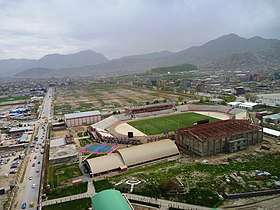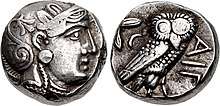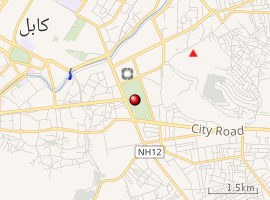Chaman-e-Hozori
Chaman-i Hazouri (Dari: چمن حضوری)[1] or Hazoori Chaman (Pashto: حضوري چمن) is a park in downtown Kabul, Afghanistan.[2] It is the site of the famous Chaman Hazouri hoard (or Kabul hoard) of ancient coins and jewellery dating back to the Achaemenid Empire (c.550–330 BCE), which is of key interest to the historians.[1]
| Chaman-e-Hozori | |||
|---|---|---|---|
| چمن حضوری | |||
 Chaman Hozori park beyond the Ghazi Stadium (view from the north)
| |||
| Location | Kabul, Afghanistan | ||
| Status | Active | ||
Description
Chaman Hozori park lies at the foot of the Tepe Maranjan hill, close to the Kabul River passing through the Kabul city centre. The Ghazi Stadium is immediately to the north of the park. The park is currently used as a meeting place and parade ground, especially during the Republic Day (Jeshn-i-Jamhuriat) celebrations around 17 July. During the reign of Amir Habibullah (1901–1919), the area was used as a golf course.[1]
The park was also referred to as "Jeshyn grounds" due to the celebration of annual independence day celebrations there.[3] For the 1956 Jeshyn fair, which was billed as "international", the Soviet Union and the United States vied with each other for creating their exhibitions. R. Buckminister Fuller was commissioned to design a geodesic dome for the US exhibition, which was manufactured in North Carolina and flown to Kabul so that it could be assembled by local Afghan workers within two days.[4][5]
Chaman Hozori hoard

In 1933, when foundations were being dug for a house close to the park, an ancient pot was discovered containing jewellery and around 1,000 coins. 127 coins and pieces of jewellery were taken to the Kabul Museum and others made their way to various museums in British India and elsewhere. Some two decades later, Daniel Schlumberger of Délégation Archéologique Française en Afghanistan (DAFA) published photographs and details of the finds stored in the Kabul Museum in a book titled Tresors Monetaire en Afghanistan.[6][7]
The Chaman Hozori coins remained at the Kabul Museum until 1992–1993, at which time the Mujahideen fighting the Afghan civil war plundered the museum. All the coins were lost (along with various other artifacts). Some two years later, 14 coins from the collection surfaced in a private collection in Pakistan. Osmund Bopearachchi and Aman ur Rahman published their details in the book Pre-Kushana Coins in Pakistan (1995).[6]
The Chaman Hozori hoard is of high interest to the historians because it contains a significant coin, an imitation of an Athenian tetradrachm, whoc can be dated, approximately to 380 BCE. From this coin, the numismatists wer able to date the hoard and giving historical basis for all other finds in the hoard. In particular, numismatist Joe Cribb has postulated that the local coins found in the hoard are the earliest coins minted in South Asia and he traces the evolution of the coinage in the Indian subcontinent from this source.[8]
See also
- Shar-e Naw Park
References
- 106. Kabul: Chaman-i Hazouri, Center for Environmental Management of Military Lands (CEMML), Colorado State University and US Department of Defense, retrieved 26 October 2018.
- "Chaman Hazoori". Mapcarta. Retrieved 2017-11-11.
- American Universities Field Staff (1966), Reports Service: South Asia series, American Universities Field Staff.
- Wulf, Andrew James (2015), U.S. International Exhibitions during the Cold War: Winning Hearts and Minds through Cultural Diplomacy, Rowman & Littlefield Publishers, pp. 71–, ISBN 978-1-4422-4643-0
- The geodesic dome at the 1956 Jeshyn Fair, Meridian International Center, Washington D.C., retrieved 28 October 2018.
- Achaemenid Rule (550–330 BC), Center for Environmental Management of Military Lands (CEMML), Colorado State University and US Department of Defense, retrieved 26 October 2018.
- Bopearachchi, Coin Production and Circulation 2000, pp. 300–301.
- Cribb, Dating India's Earliest Coins 1985.
Bibliography
- Bopearachchi, Osmund (2000), "Coin Production and Circulation in Central Asia and North-West India (Before and after Alexander's Conquest)", Indologica Taurinensia, International Association of Sanskrit Studies, 25
- Cribb, J. (1985), "Dating India's Earliest Coins", in J. Schotsmans; M. Taddei (eds.), South Asian Archaeology, 1983: Proceedings from the Seventh International Conference of the Association of South Asian Archaeologistan in Westeren Europe Held in the Musees Royaux d'art et d'histoire, Brussels, Naples: Istituto Universario Orientale, pp. 535–554
